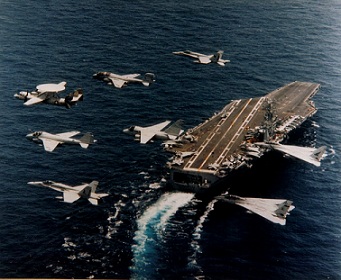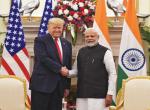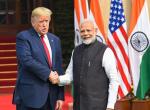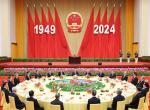The Cheonon Incident
On 26 Mar10, the South Korean Naval Ship Cheonon sank off the Coast of Korea. 46 South Korean sailors perished. A South Korean led international team of investigators determined that a torpedo fired from a North Korean submarine sank the Cheonon. North Korea however strongly refuted these allegations. This led to outrage in South Korea and the USA. The matter was discussed at the Asian Security Forum held at Hanoi recently. The US Foreign Secretary Hillary Clinton has announced a slew of sanctions designed to deny luxury goods to the North Korean elite and strangle funding for the nuclear program.
Exercise Invincible Spirit
Things heated up sharply however after the US and South Korea decided to hold a four day Naval Exercise called “Invincible Spirit” in the Yellow Sea off the Coast of Korea. The Exercise was initially scheduled for Jun this year. However there were strong objections raised by Beijing about the area of the Exercise in the Yellow Sea off the Western coast of Korea. Surprisingly, the Exercise was rescheduled thereafter and was held for four days from 25 Jul to 28 Jul on the East Coast of Korea in the Sea of Japan. Some 20 ships and submarines, 200 aircraft and some 8000 military personnel took part in these exercises. This was the first Exercise in which the US F-22 Stealth fighters were deployed in Korea. American and South Korean Defense Chiefs announced that these drills would be staged to send a clear message to North Korea to stop its aggressive behavior. The Nimitz class US Nuclear powered Air Craft Carrier USS George Washington was deployed from Japan to take part in these exercises.
The Vehement Chinese Response: Increasing Naval Assertiveness
The PLA Navy of China tracked the movement of the USS George Washington via satellite and the reaction in the Chinese media and military circles was surprising in its virulence. They trenchantly opposed the US-South Korea exercise covering the Yellow Sea and warned of the dangers of incidents if the US and South Korea went ahead with the exercise .The Chinese were specifically concerned about the entry of the US Aircraft Carrier George Washington into the Yellow Sea. Apparently the carrier has the capability to survey the hydro-geological conditions of China’s submarine channels out to the sea. The Chinese therefore termed these exercises as a strategic reconnaissance and testing of initial combat plans. They asserted that such an exercise in the Yellow Sea would exacerbate mistrust in the region and undermine its security. The Americans were taken aback but have shifted the location of the current exercise to the Sea of Japan. American naval officials however are still talking of exercising in the Yellow Sea albeit without the Air craft carrier. Chinese military analysts have increasingly been writing about a looming Naval confrontation between a hegemonic Naval Power (US) and a rising Naval Power (China).
This new phase of Chinese Naval assertiveness has been highly intriguing. B. Raman has written about the “Waters of China’s interest or Psychological Territorial Seas”. Naval analysts are intrigued by the increasing Naval assertiveness of China in the South and East China Seas and in the Yellow Sea and its increasing demand since the beginning of the year for equality of status with the US in the Western Pacific. The Chinese used to project themselves as a rising economic power. Now for the last few months – the “hide your capabilities, bide your time phase” is distinctly over and they are no longer coy about projecting themselves as a rising Naval Power.
The Carrier Killer: DF-2ID Missile
In 1995-96 China was forced to back off when the US dispatched two Carrier battle groups to the Taiwan Straits at the height of the Chinese generated crisis. China had then aggressively fired missiles over Taiwan and staged amphibious assault exercises. The approach of the Carrier Battle Groups forced China to back down. China had thereafter toned down its rhetoric and truculence for over 10 years. However its military and Naval Brass was intensively engaged in finding an answer to the challenge of US Carrier Battle Groups. The response has now come in the form of the DF-2ID Ballistic Missile. This is a mobile land based missile of 1800-2000 miles (approx 3,000 kms) range, specifically designed to engage and destroy the giant nuclear powered carriers. The DF-2ID has US Naval Strategists clearly worried. The US Navy concedes privately that they have only theoretical counter measures against the DF-2ID because its trajectory and other capabilities are largely unknown. As per US Naval Intelligence sources the DF-2ID is nearing operational capability. It could rank as the worlds first mobile land based missile capable of hitting a moving air craft carrier nearly 2000 miles away. The basic design of the DF-2ID is quite similar to the US Pershing II Missile of the Cold War era. However it is a land based platform. Its payload and the capability of a ballistic Missile to redirect in mid-flight is what especially worries US Strategists. What drives the recent aggressive assertiveness of the Chinese Navy? Is it its confidence that it finally has an answer to the US Carrier Battle Groups? The US Navy 7th Fleet Commander, Vice Adm John Bird was clearly concerned when he said, “We have some concerns over the very aggressive weapons the Chinese are processing”.
“Individually”, said Paul Giarra (a former Navy Cdr and now a Defense Deptt Analyst) “the technological capabilities are not unprecedented but it is a revolutionary combination of capabilities”. The missile would be formidable during battle and its consequences go beyond any hypothetical cataclysmic wars. The Chinese would use the missile as leverage to try to weaken US Security pledges to Taiwan and other Asian allies, establishing vast no-go zones in the West Pacific.
An active Dong-Feng 21D Missile arsenal could prove to be a significant threat to the massive nuclear powered air craft carriers. This “carrier killer” could usher in a major revolutionary change in Naval warfare which had moved from the era of Battleships to the era of Aircraft carriers in World War II. The DFs mark a significant paradigm shift that could make the strategy of sending giant Air craft carriers more dangerous because it could give China the option of firing warning shots if the US Ships sail too close for Chinese comfort says Toshi Yoshiwara; Prof of Strategy and Policy at the US Naval War College.
A small dose of well placed missiles they believe might persuade the enemy to back down or cease and desist. Such escalation could lead to miscalculation. If fired upon, the US might perceive what is intended as a warning shot or demonstration of resolve – as a prelude to all out attack.
Current US Defensive Measures The current US Missile defense systems are based on the US Aegis class Cruisers/destroyers that form part of an Air Craft Carrier Battle Group. These carry the SM-3 interceptor missiles. However Giarra noted that the interception capability of Aegis equipped ships is not enough to reliably defend against a volley of well placed Anti-ship missiles. The US option therefore would be to rely more upon submarines or else keep its surface ships out of missile range. This seems to explain the surprising rise in Chinese Naval assertiveness. B Raman has rightly pointed out that China seems to be asserting itself more and more with respect to the kinds of territorial claims. They seem to be taking a much more aggressive approach to near sea areas recently. This has serious implications for the freedom of navigation on the high seas. It virtually amounts to the enforcement of maritime exclusion zones. What is highly surprising is what precisely has impelled America to back down and hold its Naval Drill in the Sea of Japan, instead of the Yellow Sea. Was it the threat of the DF-21D? A Chinese military analyst wrote lately that “The rise of Chinese Naval Power is unstoppable. Instead of trying to counter it the US should accommodate itself with it by accepting the new reality in the Western Pacific as a result of the rise of the Chinese Navy”. Beijing now has an expanded list of core sensitivities that go far beyond Taiwan and Tibet.
The North Korean Response
The North Korean response has been equally strident. It had threatened to unleash a sacred war and a nuclear response. North Korea’s National Defense Commission gave an unprecedented warning from a nuclear armed nation. “The Army of the People of North Korea will legitimately counter with their powerful nuclear deterrent the largest ever nuclear – war exercises”. The virulence of the collective Chinese – North Korean response has apparently worried the Americans enough to shift the venue of the exercises from the Yellow Sea to the Sea of Japan.
Admiral Mike Mullen’s Concern
In his recent visit to India, US Chairman Joint Chiefs of Staff, Admiral Mike Mullen clearly articulated his growing concern over China’s recent Naval assertiveness and muscle flexing. Beset with a financial crisis and bogged down with ongoing insurgencies in Iraq and Afghanistan, the Obama Administration’s first impulse after coming to office, was to seek accommodation with China at the global level and alliance with Pakistan at the regional scale. India was completely marginalized from its world view and pilloried to make peace with Pakistan. Obama’s visit to China however was a significant come down. Chinese assertiveness in the climate change negotiations further convinced the Americans that China only respected strength. They retaliated by providing $ 6 Billion worth of arms to Taiwan. This entrained a negative cycle that is now manifesting in the crisis in East Asia and the increasing Naval muscle flexing by China. The Americans are clearly concerned and Admiral Mullen articulated this concern unambiguously in his visit to India. He stated inter alia “I have moved from being curious about what they are doing to being concerned about what they are doing”
He elaborated
“I see a fairly significant investment in high end equipment, satellites, ships and Anti- ship missiles and high end aircraft. They are shifting focus from ground forces to a focus on their Navy and Air Force”. He also stated significantly that
“China is massing expeditionary maritime and air capabilities which seem oddly out of step with their stated goal of territorial defense”.
He was of the view that “Every nation has a right to defend itself and spend as much as it deems fit for that purpose. But a gap as wide as what seems to be forming between China’s stated intent and its military progress, leaves me more than curious about the end result”.
In Oct 2009 Gen Xu Caihai, Vice Chairman of the Central Military Commission of China had visited the USA. He was taken to several bases stretching from the East Coast to Hawaii. This gave US officials hope that it was the beginning of a normalization period between the two militaries. However in Jun 09, the US sold over $ 6 Bn worth of arms to Taiwan and the whole process ground to a halt.
Mullen had then stated “China is a leader in the region – a rising leader. We welcome its considerable strength and potential. The Question is should China and US work together, lead together, to promote regional stability? Mullen had the said “Washington’s answer is and has been an unequivocal yes. Beijing’s answer has been sometimes yes and sometimes no”.
Things have apparently changed in 2010. With the Beijing Olympics China threw its coming of age party. The Global financial crisis found America considerably weakened. China sensed its break out opportunity and in 2010 there has been a dramatic turn around from its “Hide your capabilities bide your time” phase. Its military build up has given new confidence and assertiveness to the PLA the PLAN and the PLAFF. The DF-2ID seems to have exorcised the threat of American Carrier Battle Groups and introduced a significant game changer in the Naval arena of the Western Pacific Ocean. China is now flexing its muscles. China’s recent attempt to virtually enforce maritime exclusion zones in the South China Sea, East China Sea and the Yellow Sea forms a very disturbing precedent. It has obvious implications for the freedom of navigation on the high seas. This obviously concerns the USA and it equally has implications for India.
It is hoped that Mike Mullen’s visit to India will correct the blatantly pro-Pakistan distortions that had crept into the American regional perspective. In a rising and assertive China, both India and the USA face a common threat and challenge. The Democratic administration before long may have to revive the idea of a concert of democracies. The Global Financial Crisis is being seen by the Chinese as a significant game changer that has hastened its coming of age as a global power. The pattern shift in Chinese state behaviour has serious implications for Asia and the World in general and India in particular. Indian National Security experts need to take serious note of these tectonic plate shifts and speed up our inordinately delayed military build up. We can not afford to post pone the completion of our military buildup to 2025. The crisis situations are building up far quicker than anticipated in Asia. We can not afford to be overtaken by events once more.
Paradigm Shift in Naval Warfare
The Dong Feng -2ID Ballistic Missile as a Carrier killer could generate a Naval RMA. It could have a huge impact on the way Navies fight. India has invested in a major way in acquiring tactical to mid sized air craft Carriers. It must factor in the impact of the DF-2ID threat to its CBGs. India has developed considerable expertise in developing autarky in missiles. The DRDO must rapidly produce such Carrier Killer Ballistic Missiles as also defensive systems against such attacks on our own CBGs. It is ushering in a new era in Naval Warfare and we can not afford to be left behind. The Carrier Killer Ballistic Missile is a significant game changer. It is also cheap and affordable and the earlier we acquire this capability the better it will be for us. We also need to invest in countering this new threat – otherwise our own CBGs will have to be confined to harbours in future Naval Battles. The rate and pace of change is accelerating in our times. We have no option but to keep pace.
References
1.“North Korea Warns of Nuclear Strike”. Times of India, 23 Jul 10 Issue.
2.Ibid
3.Ibid
4.Preet Nahan “UNSC Statement on Cheonon” . IDSA Comment.
5.Ibid
6.Ibid
7.John Raberoff “Mullen Reiterates Concern over China’s Military Build Up” .Stars and Stripes 21 Jul 10
8.Ibid
9.Ibid
10.Ibid
11.Ibid
12.Ibid.
13.B.Raman. C 3S Paper No 548, 24 Jul 10. Institute of Topical Studies Chennai.
14.Ibid
15.Kevin Barren “China’s Naval Assertiveness”, Stars and Stripes. 09 Jun 10.
16.Ibid
17.Ibid
18.Ibid










Post new comment